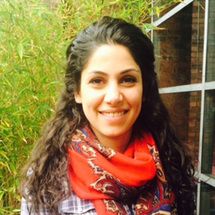
Iranian visual and textile artist Paria Goodarzi (pictured right) will present her seven piece Batik collection at the ‘Being Human’ exhibition, launching this Thursday (4 June) as part of Refugee Festival Scotland. She is also behind the design of this year’s festival tote bags, inspired by the cultural textile similarities between Scotland and Iran.
Artist Paria has previously exhibited in Iran, but this will be the first time her work goes on display in Scotland. Her exhibition joins a programme of visual art by Iranian refugees celebrating the theme of ‘Being Human’, which also includes work by photographer Iman Tajik.
The process from sketch to finished piece with Paria’s Batiks took the artist more than a year to complete.
Paria said, “I want to show people the Iranian culture and how other cultures often merge together. It is amazing the similarities in textiles between different cultures. I hope people come and enjoy it.”
Showcasing traditional Iranian design
The designs focus on the theme of constraint – reflecting on certain periods of time in Iran and her own personal experiences. The seven pieces signify the belief in her faith of the creation of the world in seven days, including Iranian motifs of ‘earth’ and ‘sea’. The pieces are each exactly the same in size and the square presentation signifies a shape of ‘power’.
“Batik textiles actually originate from Indonesia and were adopted by Iran and are now a very traditional textile there,” explained Paria.
Reflecting on the delicate process of creating Batik textiles, Paria said, “I draw with a brush and wax. It’s quite a long and detailed process, and sometimes difficult to control the wax especially using the satin after painting and drawing. I then need to remove the wax with heat.”
The textiles use rich colours to reflect the traditional textiles and interiors of Iran. Playing with colours, with influences from her time in Scotland, is a big part of Paria’s design.
Tote bags – merging cultures
In Iran her interest in art and textiles started from an early age. Her mother was a fashion designer and her father worked in production. In coming to Scotland she was surprised by the similarities in both cultures’ textile history.
Paria said, “Scotland and Iran both have very rich histories in weaving. For example, Paisley Pattern is used on many Iranian traditional costume and interiors.”
After helping with design workshops at Scottish Refugee Council, Paria discovered that Paisley Pattern is also a traditional textile in many other countries. When asked to design the tote bags this year she focused on this pattern and how it merges these different cultures together. Then used colours and design inspirations from Scotland as well as traditional motifs from Iranian and Arabic countries.
